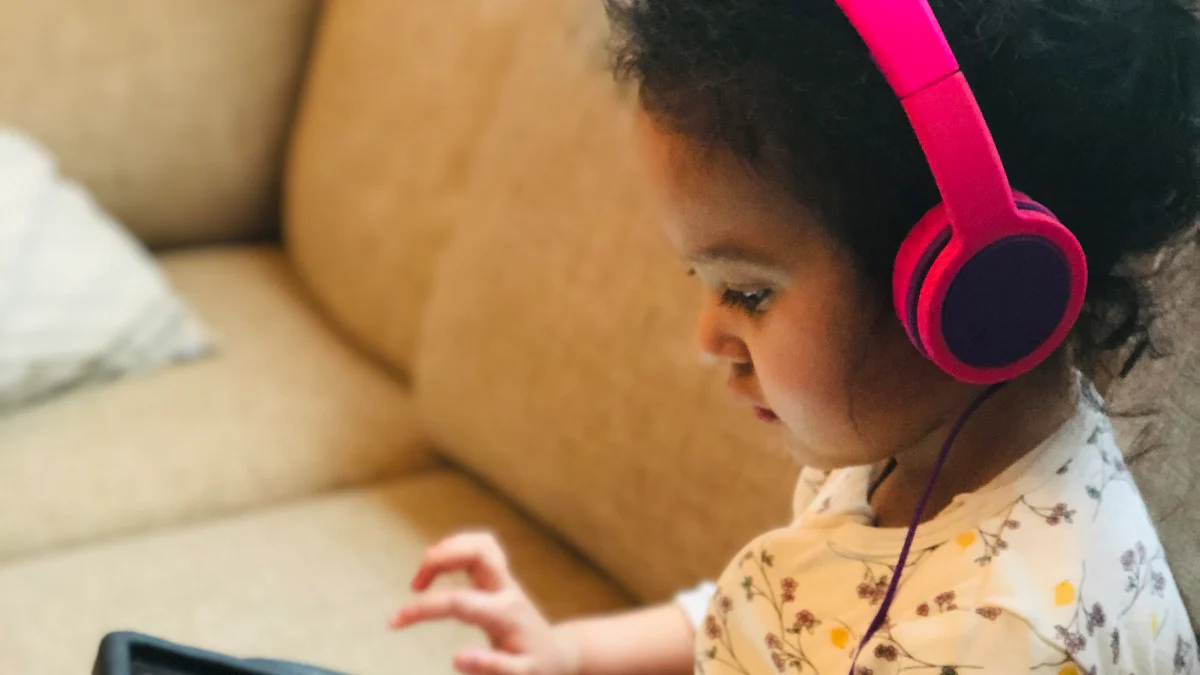- Explore
- Blog
- How to Protect Your Child with Parental Controls on Android Tablets
How to Protect Your Child with Parental Controls on Android Tablets


The internet can be a wonderful place for learning and entertainment, but it also hides risks that no parent wants their child to face. Studies show that 1 in 4 children encounter harmful content online, and nearly 10% receive inappropriate messages. These numbers highlight why protecting your child’s digital experience is so important. Android tablet parental controls give you the power to filter content, manage screen time, and monitor app usage. Setting up parental controls on Android is simple and ensures your child stays safe while exploring the digital world. Kid-proofing Android phones has never been easier.
Key Takeaways
Utilize built-in parental controls on Android devices to restrict app downloads, block inappropriate content, and set screen time limits.
Download and set up Google Family Link to create a supervised account for your child, allowing you to monitor their activity and approve app downloads.
Consider third-party apps like Qustodio or Bark for advanced features such as real-time alerts and detailed activity reports to enhance your parental control toolkit.
Encourage the use of child-friendly browsers like Kiddle or KidRex to ensure your child accesses only age-appropriate content online.
Regularly review and adjust parental control settings as your child grows to keep their digital environment safe and relevant to their maturity level.
Set up purchase approvals in the Google Play Store to prevent unauthorized transactions and ensure you have control over what your child can buy.
Engage in open communication with your child about their online activities to build trust and guide them toward responsible digital habits.
Overview of Android Tablet Parental Controls
When it comes to protecting your child in the digital world, Android provides a variety of tools to help you stay in control. These tools ensure your child has a safe and age-appropriate experience while using their tablet. Let’s explore the options available to you.
Built-in parental control features on Android
Android devices come with built-in parental controls that are easy to set up and use. These features allow you to manage what your child can access on their tablet. For example, you can restrict app downloads, block inappropriate content, and even set screen time limits.
One of the most powerful tools is Google’s Family Link. This app lets you create a supervised account for your child. With Family Link, you can approve or block apps, monitor screen time, and even locate the device if needed. It’s a comprehensive solution that gives you peace of mind while your child explores their tablet.
To enable these controls, head to the settings menu on the tablet. From there, you can activate content filters, set maturity ratings for apps, and manage other restrictions. These built-in features are a great starting point for ensuring your child’s safety.
Third-party apps for enhanced parental controls
While Android’s built-in tools are effective, third-party apps can take parental controls to the next level. Apps like Qustodio, Bark, and Net Nanny offer advanced features that go beyond what’s available by default. These apps provide detailed activity reports, real-time alerts for harmful content, and even social media monitoring.
For instance, Qustodio allows you to track your child’s online activity across multiple devices. Bark specializes in detecting potential risks like cyberbullying or exposure to inappropriate material. Net Nanny offers robust web filtering and customizable screen time schedules. These apps work seamlessly with Android tablets, giving you more control over your child’s digital habits.
If you feel the built-in tools aren’t enough, consider adding one of these apps to your parental control toolkit. They’re designed to complement Android’s features and provide an extra layer of protection.
Importance of child-friendly browsers for safe browsing
Browsing the internet can expose your child to a wide range of content, not all of which is suitable for their age. That’s why using a child-friendly browser is essential. These browsers are specifically designed to block harmful websites and ensure a safer online experience.
Options like Kiddle and KidRex are excellent choices. They filter search results to show only child-appropriate content. Some browsers even allow you to customize the filters based on your preferences. This way, you can ensure your child only accesses educational and entertaining websites.
Encouraging your child to use these browsers helps them develop good online habits. It also reduces the risk of them stumbling upon inappropriate material. Combined with other parental controls, child-friendly browsers create a safer digital environment for your little one.
How to Set Up Parental Controls Using Google Family Link

Setting up parental controls on your child’s Android tablet doesn’t have to be complicated. The Google Family Link app makes it easy to manage your child’s digital habits and ensure their online safety. Follow these steps to get started.
Downloading and installing Google Family Link
First, you’ll need to download the Family Link app on both your device and your child’s Android tablet. Open the Google Play Store, search for "Google Family Link," and install the app. It’s free and works seamlessly with Android devices.
Once installed, open the app on your device. You’ll see a simple setup process that guides you through connecting your account to your child’s. Make sure both devices are connected to the internet during this step. If your child’s tablet doesn’t already have the app, you can install it directly from the Play Store.
Pro Tip: Ensure your child’s tablet is running the latest version of Android for the best compatibility with Family Link.
Creating and linking a child account
After installing the app, the next step is to create and link a child account. If your child already has a Google account, you can link it to Family Link. If not, you’ll need to create one. The app will guide you through this process.
To create a new account, enter your child’s information, including their name and date of birth. Google uses this information to apply age-appropriate restrictions automatically. Once the account is ready, link it to your Family Link app by following the on-screen instructions.
When the accounts are linked, you’ll gain access to a dashboard where you can manage your child’s settings. This includes approving apps, setting restrictions, and monitoring activity. Linking the account ensures you stay in control of your child’s digital experience.
Managing screen time, app permissions, and activity reports
The Family Link app gives you powerful tools to manage your child’s tablet usage. You can set screen time limits to ensure they don’t spend too much time online. For example, you can allow two hours of usage on weekdays and three hours on weekends. Adjust these limits based on your family’s needs.
You can also approve or block apps before your child downloads them. This feature is especially useful for preventing access to apps that aren’t age-appropriate. For added safety, consider allowing only apps like YouTube Kids, which offers a curated selection of child-friendly videos.
Activity reports provide insights into how your child spends their time on the tablet. You can see which apps they use the most and how long they spend on each one. Use this information to guide conversations about healthy digital habits.
Quick Tip: If your child tries to access restricted content, you’ll receive a notification. This allows you to address the issue immediately.
By using Google Family Link, you can create a safe and structured digital environment for your child. The app’s features make it easy to monitor activity, set boundaries, and encourage responsible tablet use.
Enabling Parental Controls on Google Play
Managing what your child can access on Google Play is essential for creating a safe digital environment. With Google Play parental controls, you can restrict content, set age-appropriate filters, and even control purchases. Let’s dive into how you can set these up effectively.
Setting content restrictions for apps, games, movies, and books
Google Play allows you to filter content based on your child’s age and maturity level. This feature ensures they only access apps, games, movies, and books that are appropriate for them. To get started, follow these steps:
Open the Google Play Store on your child’s Android tablet.
Tap the profile icon in the top-right corner and select Settings.
Navigate to Family and choose Parental controls.
Enable parental controls by setting a PIN. This PIN ensures only you can modify the restrictions.
Under Content restrictions, select categories like apps, games, movies, and books. Adjust the maturity level for each category based on your child’s age.
For example, you can allow apps rated for ages 3+ while blocking those meant for teens or adults. These settings apply across the Google Play Store, ensuring your child only sees content that matches the restrictions you’ve set.
Quick Tip: Regularly review these settings as your child grows. Their needs and maturity levels will change over time.
Enabling purchase approval to prevent unauthorized transactions
Children often explore apps and games that include in-app purchases. Without proper controls, they might accidentally make purchases, leading to unexpected charges. To prevent this, you can enable purchase approval on Google Play. Here’s how:
Open the Google Play Store on your device.
Go to Settings and select Authentication.
Tap Require authentication for purchases and choose For all purchases through Google Play on this device.
This setting ensures that every purchase requires your approval. Whether it’s a new app, a game upgrade, or an in-app item, your child won’t be able to complete the transaction without your consent.
If you’re using Google Family Link, you can take this a step further. Family Link allows you to manage purchase approvals directly from your device. When your child tries to buy something, you’ll receive a notification. You can then decide whether to approve or block the request.
Pro Tip: Combine purchase approval with content restrictions for maximum control. This way, you can both filter content and prevent in-app purchases.
By setting up these controls, you can protect your child from accessing inappropriate content and making unauthorized purchases. These tools give you peace of mind while allowing your child to enjoy their Android tablet safely.
Setting Up Restricted Profiles or Child Accounts

Creating a safe digital space for your child is easier when you use restricted profiles or child accounts on Android tablets. These features allow you to control what your child can access, ensuring they only interact with age-appropriate content. Let’s walk through how to set this up and customize it for your child’s needs.
How to create a restricted profile on an Android tablet
A restricted profile is a great way to give your child access to a tablet without worrying about them stumbling upon inappropriate content. This feature limits what they can see and do, making the tablet safer for their use. Here’s how you can create one:
Open the Settings app on your Android tablet.
Scroll down and select Users & accounts or simply Users, depending on your device.
Tap Add user or profile and choose Restricted profile.
You’ll be prompted to set up a PIN or password if you haven’t already. This ensures only you can manage the profile settings.
Once the restricted profile is created, you’ll see a list of apps and features. Use the toggles to decide what your child can access.
Quick Tip: If you’re unsure about certain apps, it’s better to disable them initially. You can always enable them later as your child grows or their needs change.
This setup creates a separate environment on the tablet, so your child won’t have access to your personal apps, files, or settings. It’s a simple yet effective way to ensure their safety.
Customizing app and content access for the child
After creating the restricted profile, you can fine-tune it to match your child’s needs. Android makes it easy to customize access to apps, features, and content. Follow these steps to get started:
Enable or disable apps: In the restricted profile settings, you’ll see a list of installed apps. Toggle the switch next to each app to allow or block access. For example, you might enable educational apps like Khan Academy Kids while blocking social media platforms.
Set content restrictions: Pair the restricted profile with tools like Google Play parental controls or Family Link. These tools let you filter content by age, ensuring your child only sees appropriate apps, games, and media.
Control internet access: If your child needs to browse the web, consider installing a child-friendly browser like Kiddle. You can also block access to standard browsers to prevent unfiltered internet use.
Pro Tip: Regularly review the profile settings. As your child grows, their interests and maturity level will change, so their digital environment should evolve too.
Customizing the restricted profile gives you full control over your child’s tablet experience. It ensures they can enjoy the device safely while you maintain peace of mind.
Additional Tools and Tips for Android Parental Controls
Recommended third-party parental control apps
If you want more advanced features than what’s built into Android, third-party parental control apps can be a game-changer. These apps offer tools to help you monitor and manage your child’s digital activities effectively. Here are some top recommendations:
Kaspersky Safe Kids: This app works on Android and other platforms. It lets you track your child’s location, block apps, filter web content, and set screen time limits. It’s a comprehensive tool for ensuring your child’s safety.
Qustodio: Known for its versatility, Qustodio allows you to monitor calls and texts, block apps, and filter inappropriate content. It also provides detailed activity reports, helping you understand your child’s online behavior.
Bark: Bark specializes in detecting risks like cyberbullying or exposure to harmful content. It also includes features like screen time management and location tracking.
OurPact: This app offers robust tools for managing screen time and blocking apps. It also filters web content and tracks your child’s location, making it a reliable choice for Android users.
Norton Family: With support for unlimited devices, Norton Family lets you block apps, filter web content, and track your child’s location. It’s ideal for families with multiple children.
These apps complement Android’s built-in parental controls, giving you more flexibility and control. Choose one that fits your family’s needs and start creating a safer digital environment for your child.
Pro Tip: Many of these apps offer free trials. Test them out to see which one works best for your family.
Using child-friendly browsers for safe internet access
Browsing the internet can expose your child to inappropriate content. A child-friendly browser can help you avoid this issue. These browsers are designed to filter harmful websites and provide a safer online experience.
Kiddle: This search engine filters results to show only child-appropriate content. It’s easy to use and ensures your child stays within a safe digital space.
KidRex: Similar to Kiddle, KidRex blocks harmful websites and focuses on educational and entertaining content.
Safe Browser: Some parental control apps, like Norton Family, include their own safe browsers. These browsers allow you to customize filters and monitor browsing activity.
Encourage your child to use these browsers instead of standard ones. This small change can significantly reduce the risk of exposure to harmful material. Pairing a child-friendly browser with tools like Google Family Link ensures a secure browsing experience.
Quick Tip: Bookmark these browsers on your child’s tablet for easy access.
Managing data usage and setting limits
Excessive data usage can lead to unexpected charges and unhealthy screen habits. Managing your child’s data usage is essential for maintaining control over their online activities. Here’s how you can do it:
Set data limits: Most Android devices allow you to set data usage limits. Go to the tablet’s settings, find the “Data Usage” section, and set a cap. This ensures your child doesn’t exceed the allowed data.
Use Wi-Fi only: Restrict your child’s tablet to Wi-Fi connections. This prevents them from using mobile data and helps you monitor their online activities more easily.
Monitor with apps: Apps like Google Family Link let you track your child’s data usage. You can see which apps consume the most data and adjust permissions accordingly.
Disable background data: Some apps use data even when not in use. Disable background data for non-essential apps to save on usage.
By managing data usage, you can encourage healthier digital habits and avoid unnecessary expenses. Combine these steps with other parental controls to create a well-rounded approach to your child’s online safety.
Pro Tip: Review your child’s data usage regularly. This helps you identify patterns and make adjustments as needed.
Tips for monitoring and adjusting settings as your child grows
As your child grows, their digital needs and habits will evolve. What works for a younger child may not suit an older one. Regularly monitoring and adjusting parental control settings ensures that your child’s online experience remains safe and age-appropriate. Here are some practical tips to help you adapt as they grow:
Review content restrictions periodically
Children’s interests change over time. A game or app that was once suitable might no longer align with their age or maturity. Check the content restrictions you’ve set on their tablet every few months. Adjust the maturity levels for apps, games, movies, and books in Google Play to match their current stage of development. This dynamic approach keeps their digital environment relevant and secure.Encourage open communication
Talk to your child about their online activities. Ask them what apps they enjoy, what websites they visit, and if they’ve encountered anything that made them uncomfortable. These conversations help you understand their needs and guide them toward responsible online behavior. It also builds trust, making them more likely to share concerns with you.Update screen time limits
As your child grows, their responsibilities and routines will change. A younger child might need stricter screen time limits, while an older one may require more flexibility for schoolwork or hobbies. Use tools like Google Family Link to adjust daily usage limits. For example, you can allow extra time for educational apps while keeping recreational use in check.Introduce new tools and features
Older children may benefit from additional tools like activity reports or app usage summaries. These features, available in apps like Google Family Link or third-party parental control apps, provide insights into how they spend their time online. Use this information to guide discussions about balancing screen time with other activities.Adapt internet access settings
As your child becomes more independent, they might need broader internet access for research or communication. Introduce child-friendly browsers like Kiddle or KidRex to ensure safe browsing. Gradually allow access to standard browsers when you feel they’re ready, but keep web filters active to block harmful content.Reassess app permissions
Some apps may become more relevant as your child matures. For instance, educational platforms or collaborative tools might be necessary for school projects. Review the apps they use and enable permissions for those that support their growth while blocking unnecessary or distracting ones.Stay informed about new risks
The digital world changes rapidly. Stay updated on emerging online trends, apps, and potential risks. This knowledge helps you make informed decisions about which settings to adjust and when to introduce new restrictions.
Pro Tip: Set reminders to review your child’s settings every three to six months. This ensures their digital environment evolves alongside their needs.
By actively monitoring and adjusting parental controls, you can create a safe and supportive digital space for your child. This approach not only protects them but also teaches them how to navigate the online world responsibly.
Protecting your child’s online experience doesn’t have to feel overwhelming. By taking simple steps to set up parental controls on their Android tablet, you can create a safer and more secure digital environment. Tools like Google Family Link make it easy to manage screen time, filter content, and monitor activity. These features empower you to shield your child from harmful content while encouraging healthy online habits. Start today and take proactive steps to ensure your child’s safety. With the right tools, you can confidently guide them through the digital world.
FAQ
How do I set up parental controls on an Android tablet?
Setting up parental controls on an Android tablet is simple and effective. Start by navigating to the Settings menu on the device. From there, locate the Digital Wellbeing & parental controls section or go directly to the Google Play Store settings under the Family tab. Enable parental controls by creating a PIN, which ensures only you can modify the settings. You can then restrict apps, games, movies, and books based on age ratings. For more advanced control, download the Google Family Link app to manage screen time, approve app downloads, and monitor your child’s activity.
Quick Tip: Always ensure the tablet’s software is updated to access the latest parental control features.
Are any other parental controls needed on Android?
Yes, additional parental controls can enhance your child’s safety. While Android’s built-in tools are effective, third-party apps like Qustodio or Net Nanny offer advanced features such as real-time alerts, detailed activity reports, and social media monitoring. These apps complement Android’s settings, giving you more control over your child’s online experience. Combining built-in tools with third-party apps ensures a safer and more comprehensive digital environment.
Can I limit my child’s screen time on an Android tablet?
Absolutely! Android tablets allow you to set screen time limits through the Digital Wellbeing & parental controls feature or the Google Family Link app. With Family Link, you can customize daily usage limits, set bedtime restrictions, and even lock the device remotely when it’s time for a break. For example, you might allow two hours of screen time on school days and three hours on weekends. Adjust these limits as needed to encourage healthy habits.
How can I prevent my child from making unauthorized purchases?
To stop unauthorized purchases, enable purchase approval in the Google Play Store settings. Go to Settings, select Authentication, and choose Require authentication for all purchases. If you’re using Google Family Link, you’ll receive notifications whenever your child tries to make a purchase. This allows you to approve or deny the request instantly. These steps ensure your child doesn’t accidentally rack up charges while exploring apps or games.
What’s the best way to block inappropriate content?
Blocking inappropriate content starts with enabling content filters in the Google Play Store. Set age-appropriate restrictions for apps, games, movies, and books. Additionally, use a child-friendly browser like Kiddle or KidRex to ensure safe internet browsing. For more robust filtering, consider third-party parental control apps that offer customizable web filters and block harmful websites automatically.
Can I monitor what my child does on their tablet?
Yes, you can monitor your child’s activity using the Google Family Link app. It provides detailed activity reports showing which apps your child uses and how much time they spend on each one. Some third-party apps, like Bark or Qustodio, also offer advanced monitoring features, including alerts for risky behavior or exposure to harmful content. These tools help you stay informed and guide your child toward responsible digital habits.
How do restricted profiles work on Android tablets?
Restricted profiles create a separate, controlled environment on the tablet. When you set up a restricted profile, you decide which apps and features your child can access. To create one, go to Settings, select Users & accounts, and add a Restricted profile. Customize the profile by enabling or disabling specific apps. This feature ensures your child only interacts with age-appropriate content while keeping your personal files and apps secure.
Should I use a child-friendly browser?
Yes, a child-friendly browser is an excellent tool for safe internet access. Browsers like Kiddle and KidRex filter search results to display only child-appropriate content. Some parental control apps also include their own safe browsers with customizable filters. Encourage your child to use these browsers instead of standard ones to reduce the risk of encountering harmful material.
How often should I update parental control settings?
You should review and update parental control settings every few months. As your child grows, their needs and interests will change. Adjust content restrictions, screen time limits, and app permissions to match their current age and maturity level. Regular updates ensure their digital environment remains safe and relevant.
Pro Tip: Set reminders to revisit these settings periodically. This helps you stay proactive in managing your child’s online safety.
What if my child bypasses the parental controls?
Children are often curious and may try to bypass restrictions. To prevent this, use strong PINs or passwords for parental controls and avoid sharing them with your child. Regularly check activity reports through tools like Google Family Link to spot any unusual behavior. If you notice attempts to bypass controls, have an open conversation with your child about the importance of online safety and the reasons behind the restrictions.













